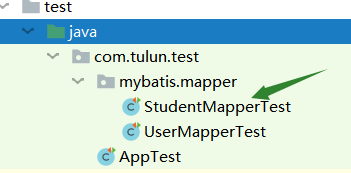mybatis框架
一、mybatis
mybits介绍
MyBatis 是一款优秀的持久层框架
特征:
1、支持自定义 SQL(非自定义SQL:hebineate)、存储过程以及高级映射。
2、MyBatis解决JDBC 代码以及设置参数和获取结果集的工作。
3、MyBatis通过XML 或注解来配置和映射原始类型、接口和 Java POJO(Plain Old Java Objects,普通老式 Java 对象)为数据库中的记录
mybatis原理

二、mybits的应用
1.配置
1.在xml文件中引入依赖
<!--mybatis-->
<dependency>
<groupId>org.mybatis</groupId>
<artifactId>mybatis</artifactId>
<version>3.4.1</version>
</dependency>
2.全局配置文件(mybatis-config.xml)
以test_tulun库为例:
<?xml version="1.0" encoding="UTF-8" ?>
<!DOCTYPE configuration
PUBLIC "-//mybatis.org//DTD Config 3.0//EN"
"http://mybatis.org/dtd/mybatis-3-config.dtd">
<!--根标签-->
<configuration>
<!--配置数据源-->
<environments default="development">
<!--id:环境的唯一标识-->
<environment id="development">
<!--事务管理器-->
<transactionManager type="JDBC"></transactionManager>
<!--数据源类型-->
<dataSource type="POOLED">
<property name="driver" value="com.mysql.jdbc.Driver"/>
<property name="url" value="jdbc:mysql://localhost:3306/test_tulun"/>
<property name="username" value="root"/>
<property name="password" value="root"/>
</dataSource>
</environment>
</environments>
</configuration>
3.定义一个pojo类
/**
* 和数据库中的Student表对应
*/
public class Student {
private Integer sid;
private String sname;
private String sex;
private Integer sage;
//省略的getter和setter方法,toString()方法
}
4.Mapper接口文件(StudentMapper.java)
public interface StudentMapper {
public Student selectStudentById(Integer id);
}
5.配置mapper.xml文件(StudentMapper.xml)
mapper.xml配置文件中是配置SQL语句的,mapper接口文件中每一个方法在mapper.xml文件中对应一个唯一的Statement(sql)
<?xml version="1.0" encoding="UTF-8" ?>
<!DOCTYPE mapper
PUBLIC "-//mybatis.org//DTD Mapper 3.0//EN"
"http://mybatis.org/dtd/mybatis-3-mapper.dtd">
<!--mapper根标签 namespace,命令空间:保证命名空间唯一,一般是对应的mapper.java的包全路径-->
<mapper namespace="com.tulun.mapper.StudentMapper">
<!--
selectStudentById
select * from Student where SID = XXX
-->
<!--
select标签:查询操作
id属性:statement的id,用于表示定义的SQL,在同一个命名空间中id是不允许重复的
#{XXX}:输入参数的占位符,避免SQL注入
parameterType:输入参数类型
resultType:指定结果集类型
-->
<select id="selectStudentById" parameterType="int" resultType="com.tulun.pojo.Student" >
select * from Student where SID = #{id}
</select>
</mapper>
6.修改全局配置文件
在mybatis-config.xml中引入配置文件
<!--引入mapper配置文件-->
<mappers>
<mapper resource="mapper/StudentMapper.xml"/>
</mappers>
7.执行查询操作
在StudentMapper.xml文件中添加
<!--
select标签:查询操作
id属性:statement的id,用于表示定义的SQL,在同一个命名空间中id是不允许重复的
#{XXX}:输入参数的占位符,避免SQL注入
parameterType:输入参数类型
resultType:指定结果集类型
-->
<select id="selectStudentById" parameterType="int" resultType="Integer " >
select * from Student where SID = #{id}
</select>
在test下生成一个测试类

//mybatis的配置文件
SqlSession sqlSession = sqlSessionFactory.openSession();
//通过反射机制来获取到mapper实例
StudentMapper mapper = sqlSession.getMapper(StudentMapper.class);
Student student = mapper.selectStudentById(10);
System.out.println(student);
} catch (IOException e) {
e.printStackTrace();
}
}
8.总结:mybatis的使用步骤:
1、配置mybatis-config.xml全局配置文件(数据源、外部mapper)
2、创建SQLSessionFactory
3、通过SQLSessionFactory来创建SQLSession
4、通过SQLSession进行CRUD操作
5、关闭会话 SQLSession.close()操作
三、mybatis的使用
1.通过xml方式使用
需要mapper.java和mapper.xml
SQL写在我们mapper.xml文件中
查询操作
使用select标签
返回结果集可以使用resultType和resultMap两种
对于数据库表的列名和java映射类的属性名如果一致时,可以使用resultType和resultMap处理都可以
如果表列名和类属性名存在不一致时,需要使用resultMap来手动实现映射过程,如下:
<!--
resultMap标签是自定义返回结果,当返回结果指定为resultMap时使用标签
id属性:取名字 select操作时结果集通过resultMap属性指定时使用该id属性
type属性:要映射的java的全路径
id/result时对结果的自定义映射
id标签是主键使用该标签,结果集中只能设定一个id标签
result处理非主键标签
-->
<resultMap id="studentResult" type="com.tulun.test.mybatis.Pojo.Student">
<!-- <id property="" column=""/>-->
<result column="sid" property="id"/>
<result column="sname" property="sname"/>
<result column="sex" property="sex"/>
<result column="sage" property="sage"/>
</resultMap>
对于单个对应的映射还是多个对象的映射,resultType和resultMap只关注映射的对象类型,查询操作会根据是单个对象则选取selectOne方法执行,返回多个对象则使用selectList方法来执行
插入对象
<insert id="addStudent" parameterType="student">
insert into Student (sid,sname,sex,sage) values
(#{sid},#{sname},#{sex},#{sage} )
</insert>
多参数传递:
多参数接口:
public int updateNameById(String name,Integer id);
通过参数传递的name是不能被mybatis识别的,mybatis中多参数提供的有0,1,parm1和parm2作为参数,
为了解决这种多参数传递可以使用@Param注解来对参数进行绑定
public int updateNameById(@Param("name") String name,@Param("id") Integer id);
通过参数形式底层是通过map的实现方式进行参数传递,
其中map的key即为注解中的名称,value即为名称对应的值
基于xml形式需要遵循一定的规则:
1、xml配置文件中的命名空间和指向接口文件的地址(全路径)
2、mapper.java接口文件中的方法名和mapper.xml中Statement的id保持一致
3、mapper.java接口中方法参数和mapper.xml中Statement的parameterType或parameterMap的类型一致
4、mapper.java接口中方法返回值类型和mapper.xml中mapper.xml文件中Statement的resultType或resultMap类型一致
2.通过注解方法
创建表对应的pojo类型
给定mapper.xml文件
<?xml version="1.0" encoding="UTF-8" ?>
<!DOCTYPE mapper
PUBLIC "-//mybatis.org//DTD Mapper 3.0//EN"
"http://mybatis.org/dtd/mybatis-3-mapper.dtd">
<!--mapper根标签 namespace,命令空间:保证命名空间唯一,一般是对应的mapper.java的包全路径-->
<mapper namespace="com.tulun.test.mybatis.mapper.UserMapper">
</mapper>
全局配置文件中引入mapper.xml
<mappers>
<mapper resource="mapper/UserMapper.xml"/>
</mappers>
接口文件,SQL都在注解上,且注解存在mapper.java文件
public interface UserMapper {
/**
*@Select 注解即xml文件中select标签
*/
//类似与resultMap
//Results不是全局调用的,如果需要则要在相应的注解语句前加上
@Results(id = "userResult",value = {
@Result (column = "tid" ,property = "id"),
@Result (column = "tname",property = "tname")
})
@Select("select * from teacher where tid= #{id}")
public User selectUserById(Integer id);
@Insert("insert into teacher values(#{id},#{tname})")
public int addUser(User user);
}
#{}和${}区别
1.#{}在执行时将其替换为?,且sql和参数分别传递,类似于JDBC中的PreparedStatement
2.${}方法参数的传递是通过OGNL表达式进行解析的,需要调用参数中的getter方法,因此参数必须右getter存在
${}的参数是直接拼接在sql语句上的,相当于JDBC中的statem
3.安全性: 使用#{}可以放在sql注入问题






















 5920
5920











 被折叠的 条评论
为什么被折叠?
被折叠的 条评论
为什么被折叠?








